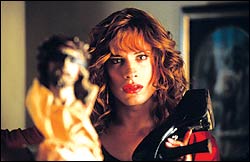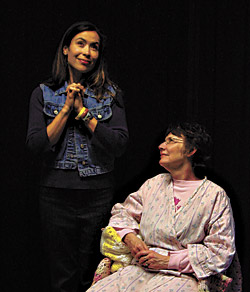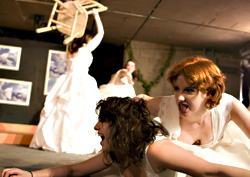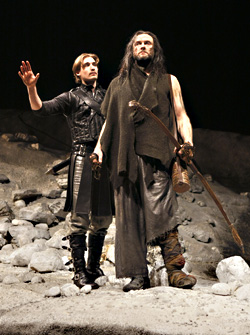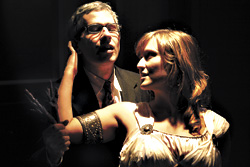If you’ve only seen Gael García Bernal as Che in The Motorcycle Diaries, you’ll be stunned by his transmogrification in Pedro Almodóvar’s Bad Education, which opens Wednesday, Dec. 22, at the Harvard Exit. (Actually, if you buy that movie’s sentimentalization of Che, the murderous worst enemy of Latin American freedom, you need some re-educating on that score, too.) What Bernal offers in Bad Education is an acting lesson. Not only does he change from his noble, muy macho Che incarnation to a conspiratorial drag queen whose smoldering beauty startlingly recalls Julia Roberts (but is, in fact, supposed to be inspired by Audrey Hepburn and Spanish diva Sara Montiel), he undergoes multiple metamorphoses in a film noir replete with flashbacks, dueling narratives, and peekaboo identity games.
He first appears, out of the blue, in the office of a film director reminiscent of Almodóvar, Enrique (Fele Martínez), circa 1980 (when Almodóvar’s career began). Wearing a wispy beard and dressed like any out-of-work actor, he reintroduces himself as Ignacio, Enrique’s first crush from Catholic boys’ school, back after 16 years, he explains; and he comes bearing a script about their scandalous adolescence, The Visit. Their budding love, consummated in the rapturous light of the local cinema, was thwarted by the priest who taught them literature (Daniel Giménez-Cacho). Father Manolo wanted Ignacio’s rosebud all for himself. Now Ignacio wants to play himself in his life story.
Now, pedophile movies are usually boring, with stock villains and foregone moral conclusions. Almodóvar’s story is too shifty to be predictable. The priest is evil, but in the grip of what clearly seems to him romance—he assaults Ignacio to the tune of “Moon River.” The scene has an unsettling romantic glow: When the priest’s eyes play across the boys’ bodies, the camera is about as innocent as Larry Clark’s leering lens in Kids. And when Ignacio reappears in the priest’s life years later (but anterior to his reunion with Enrique), he’s no innocent victim. He’s a transsexual hooker junkie and Sara Montiel–aping drag queen out to blackmail Manolo with the story of his childhood rape (the same story he later peddles to Enrique). As Ignacio extorts him, his tranny henchman is ransacking the church for gold to hawk for heroin.
At times, we’re seeing The Visit as conjured up in Enrique’s head while reading the screenplay. At other times, it’s “reality,” with the Nabokovian caution that that word must never appear except within quotes. Film-noir characters flash back to events in real people’s lives. Every soul proves to be divided—in one stunning shot, when young Ignacio submits to assault, his face literally unzips in two. Nobody is who he seems to be, and a man’s shadow is never quite his own. The priest appears both as a figure of diabolical church authority and as an old, broken man enslaved by the carnal embrace of a conscienceless drag-femme fatale, like a guy in a James M. Cain story.
Ignacio and Enrique’s idyllic childhood friendship gives way to a more ambiguous grown-up reunion. They’re just not the same guys they used to be, in so many ways. Once they were rapt in each others’ groping hands, entranced by film; now they’re two guys locked in a cold power struggle over the movie that is to define them. In one iteration of their story, grown-up Ignacio (or should we say “Ignacio”) dons a blond wig right out of Vertigo, picks up a guy, waits ’til he’s passed out, starts to rob him blind—then realizes it’s Enrique!
At first, you wonder why a movie—much of which is set in a softly golden-hued past kind of like Cinema Paradiso—opens with a credit sequence quoting Saul Bass’ Anatomy of a Murder. When all the Hitchcock-esque switcheroos culminate in a sinister, garish, carnival-like museum of giant, cackling masks, as hard-ass bastards plot a triple-cross extortion/murder, it all becomes clear. Complicated, morally and narratively, but clear. This is no formula fable, but a radical reimagining of bits of Almodóvar’s own biography, a meditation on what it means to be in movies, and to be, period. He’s come a long way from the cartoony anarchy that made his name. Almodóvar isn’t kidding anymore.
Intricately written and interlocked, dazzlingly acted, beautiful yet muted, Bad Education is one of the best movies of the year, and it may be the Spanish master’s true masterpiece.
